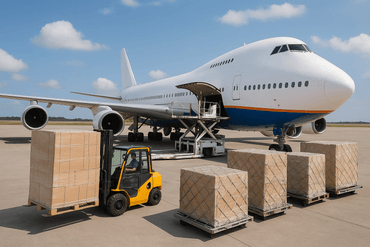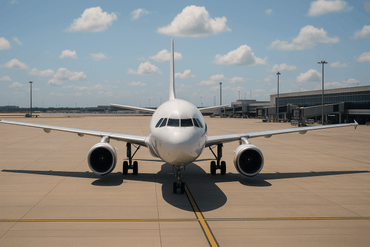
The ultimate international moving guide



What this international moving guide contains
Moving internationally? Not sure where to start? Should you go with air freight or ocean freight? A full or partial container? Is a 20-foot container enough or do you need a 40-foot container? How do you know what your best options are?
The process of moving overseas is complicated and stressful, to say the least. Importing decisions have to be made, and planning will involve a great deal of factors. Understanding the As to Zs of an international ocean freight move and what it requires is a journey on its own. To say you’re going to need some help with all of it is to, well, put it really nicely. International moving companies may be able to assist you, but there are certain things you’ll need to know for yourself.
In this international moving guide, you’ll find details regarding everything you need to know to plan your move. From deadlines and packing tips to documents required and advice, our guide has got you covered. Make sure to give this a thorough read to prevent delays, additional costs, damages, or anything that could go wrong along the way.
At iContainers, we’ve helped thousands of families with their international move. Our goal is to make the process as smooth and as painless as possible so that your biggest worry is the kind of wine you should be serving at your farewell party. Worry not. With iContainers, your personal belongings are in safe hands. Let us begin.
Part 1: Understanding the basics of an international move
What is an international move (and what is it not)
An international maritime move is a process in which a person or a family moves to another country (usually in another continent) and transports their personal belongings to the destination country via ocean freight transportation. This process involves placing items such as furnitures, cars, motorcycles, and household goods in a container on board a shipping vessel and.shipped across the ocean.
Now, what is an international move not? It may seem obvious, but sometimes it’s best to clarify. If you’re not actually moving to another country, it’s not an international move. The person sending the items need to be present at destination to receive them. If all you’re doing is send furniture, personal items, or appliances from one country to another, it is not considered an international move and you will not be able to send the items as such.
The rules for international moving shipments for individuals state that the person sending the shipment at origin needs to be the same person to receive it at destination. Besides just receiving the shipment, you’ll also need to prove that you’ve moved to and are living in the country.
Who is who in an international move
The ocean freight industry is known for its complexities. There are multiple parties involved in the long and complicated process of getting your personal belongings shipped. For your benefit and understanding, it’s best that you get to know them all.
International moves are extremely similar to maritime commercial goods shipments. The containers and ships that transport your belongings also transport the commercial goods that are being imported or exported all around the world.
So even though your freight forwarder’s role is to liaise with the different parties and guide you every step of the way, you should make the extra effort to understand the different roles involved. This will help you to communicate properly and stay on top of things to avoid misunderstandings.
Here are the main figures involved in your international move:
Shipper and consignee: In a commercial shipment, the shipper and consignee are two different people. The shipper is the sender and the consignee is the receiver. In an international move, these are one and the same: you. The person who sends the shipment from origin must be the one to receive it at destination.
Freight forwarder: The role of a freight forwarder is to inform and assist you with the details of the shipment process. This includes organizing the transportation of your personal belongings from your house or a warehouse until the final destination of your move. The freight forwarder handles all necessary documents, notifies you of any changes, and liaises with the different other parties involved in the entire international moving process. This way, even though the entire process requires communicating with many different companies, you only need to have one point of contact.
Truckers: The truckers are the people involved in picking up your personal belongings on the pick up date you’ve agreed on with your freight forwarder. They will transport a container to your doorstep and once it’s been loaded, transport it to the port. Likewise, when your belongings arrive at destination, the truckers will be the ones to transport the container to your new address or to a warehouse.
LCL consolidators: These are companies that combine different shipments together in one container. If you’re shipping relatively few items and won’t be needing a full container, you may send your items as a Less than Container Load (also known as LCL). This means your personal belongings will share a container space with others (more on this later). The role of an LCL consolidator is properly fill an entire container with LCL shipments from different shippers.
Carriers: Carriers operate the vessels that will be transporting your personal belongings to your new home. You will need to obtain confirmation from them as to whether there’s space for your container on their vessels.
Destination agents: These are the experts in customs clearance procedures, paperwork, taxes, and the specific rules and regulations of the country you’re moving to.
Every country has its own rules, exceptions, limitations, etc. It is therefore important to work with an agent at destination to help with all the documentation and procedures needed to avoid any problems with customs and secure the release of your personal belongings. The destination agent will also advise you on the amount of taxes you need to pay when your household goods arrive at the port of destination. Don’t forget to factor these in to your overall international moving costs.
Customs: Customs authorities control the import and exports of each country. They are the ones who will receive and verify the information on the documents you have submitted to make sure it corresponds with the shipment, as well as determine if there are discrepancies and if customs exams need to be conducted.
Different types of international moves: Door-to-door or door-to-port
There are different shipping options to choose from for your international move, depending on whether the pick up and delivery of your items are to be carried out at a residential address, a warehouse, or a port.
Door-to-door international moves
The main characteristic of a door-to-door international move, as its name suggests, is the pick up and delivery of your personal goods from your old home to the doorsteps of your new home.
At origin, the trucker transports the container to your doorstep for you to load your belongings. Unless you’ve hired extra help, you will be responsible for loading. This includes getting a ramp, forklift, etc. The truck driver is not obliged to assist you. Likewise, at destination, the trucker will transport the container with your belongings to your new address and you will be responsible for unloading your household items.
In door-to-door international moves, there’s no need to hire an agent at destination as the freight forwarder managing your move will be responsible for handling customs clearance in both origin and destination.
Without proper guidance and assistance, moving internationally can be extremely stressful. At iContainers, we recommend choosing door-to-door international moving services where possible to eliminate unnecessary logistical stress.
iContainers offers exclusive door-to-door ocean freight services for international moves to or from any of the following places:
Door-to-port international moves
Door-to-port international moving services end when your belongings arrive at the port of destination.
At this point, your agent at destination will need pay the necessary taxes and duties and provide the documents required for customs clearance. Once that’s completed, your personal items may be collected at the port.
The process of international moving
Now that you’re clear on what an international move is, the main players involved, and the differences between a door-to-door and door-to-port move, you’re just one tiny step away understanding all the basic concepts of an international move.
Here’s an infographic to illustrate the door-to-port process of an international move.
![]()
Door-to-door international moves are pretty much the same, the only difference being there’s no need for a destination agent. In being able to offer a door-to-door move, your freight forwarder has presence in your destination country and will be able to carry out the international moving services of the destination agent.
When arranging a door-to-door move with iContainers, we’ll handle all taxes and fees payments required at destination and secure the release of your belongings as soon as it arrives at the destination port and deliver them to you.
Part 2: Choosing the best international move
From the moment you decide to embark on a new adventure abroad, you’re also commencing a journey of decision making. As you will come to realize, there are many important decisions you will need to make along the way. The first such important decisions include:
- Air or ocean freight
- Full (FCL) or partial (LCL) container
- 20-foot, 40-foot or a high cube container
- Door-to-door or door-to-port
Air freight or ocean freight for your international move
This guide focuses on international moves via ocean freight, but you may also send your personal belongings by air. While the more common and cheaper option is by sea, air freight may be the better option if you have very specific needs. Air freight shipments are substantially more expensive than ocean freight and often have tighter limits on volume, which may not be feasible considering that an international move usually implies sending large volumes of household goods.
When is air freight the better option?
If you don’t mind the higher cost, have relatively few items to send, and need for your belongings to arrive at your destination country as soon as possible, air freight may be the better option for you. If in doubt, consult your freight forwarder.
Full (FCL) or partial (LCL) container for your international move
There are two types of shipment options available to you: a full container, also known as Full Container Load or FCL, and groupage, also known as Less than Container Load or LCL. The latter is also commonly referred to as a shared container, as your personal belongings will be sharing the container space with goods belonging to other individuals or merchandise being exported.
Whether you choose FCL or LCL will depend on the overall volume of your personal items. If you have relatively few items to send, you’ll be able to benefit from the lower** international moving costs** of shipping LCL, which is one of the cheapest options available. But given that most international moves involve the transportation of large furniture, vehicles, and dozens of boxes, chances are you’ll need to go with FCL shipping.
Here are some other factors to consider when deciding between an FCL or LCL move:
- FCL offers more security than LCL as you will have the entire container to yourself. With LCL, there’s always an additional risk of your belongings being damaged from items belonging to others. If this is a risk you’d like to avoid, opt for FCL.
- LCL shipments are more likely to be detained by customs. You may have filled in all the paperwork correctly and submitted them on time, but given that you’re sharing a container, should customs decide to examine another shipment in the same container, the entire container will need to be detained until everything is sorted out.
How to estimate the volume of your LCL
This how-to video will take you through the steps to calculating the volume of your personal belongings in cubic meters to estimate the space you’ll be needing in the container.
20-foot or 40-foot container for your international move
If you have decided to ship FCL, the next step will be to select your container size. Your possible options include: 20-foot container, 40-foot container, and a 40-foot high cube container. Each of these containers has different dimensions so you’ll need to know the total volume of your shipment pretty accurately and the number of boxes you’ll be sending to determine the best container size for you.
The 20-foot and 40-foot containers are more popular for international moves. Here are the dimensions of each of these containers.
Moving internationally with a 20-foot container
A 20-foot container measures 5.898m (L) by 2.352m (W) by 2.393m (H). It has a capacity of 32.6m3, which is generally enough to accommodate everything in a 80m2 apartment. This includes all the furniture and appliances in the living room, kitchen, bedrooms, bicycles and/or a motorcycle, and 20 boxes.
If you think you’ll be needing at least half of the space of a 20-foot container, FCL is probably the better and cheaper option than LCL, which is a good way to lower your international moving costs.
![]()
Moving internationally with a 40-foot container
A 40-foot container measures 12.025m (L) by 2.352m (W) by 2.393m (H). It has a capacity of 67.6m3, which is enough to fit all the items in a 100m3 apartment plus a car and a couple of motorcycles or bicycles.
If you’re taking your car with you to your new home, a 40-foot container is the way to go.
![]()
Part 3: International moving requirements
Required documents for an international move
Upon reserving your international move, your freight forwarder will ask you to fill out and submit certain documents needed to clear customs. It’s important to know what these documents are for to know how to fill them out properly. Pay extra attention to this section as even the smallest oversights could make the difference between a smooth shipping experience and massive delays which can really inflate your total international moving cost.
Depending on your destination country, you may be required to submit additional documents. But in general, this is the list of documents you’ll need to submit regardless of where you’re moving to:
- Packing list: This is where you detail the items in every single box you’re shipping. Think of the packing list as a declaration form for your household goods. Each box listed on the packing list should be accompanied by a description of the items it contains (eg. books and files), its dimensions, weight, and value. You will also need to indicate the overall dimension, weight, and value of your entire shipment. Fill this out accurately and carefully to prevent problems with customs. Plus, it may also help with when you’re unpacking at destination to make sure that you’ve received everything in order.
- Power of attorney form: This document authorizes your freight forwarder to arrange customs clearance on your behalf. You will need to sign it and return it to your freight forwarder.
- Copy of your ID/passport
- Terms and conditions: This document lists the conditions that will govern your international move. Give this document a thorough and detailed read to fully understand it and avoid any problems during the shipping process.
If you’re taking your car with you, there are additional documents that will be required. Again, specific documents may be needed depending on your port of origin and destination country (more on this later). In general, these are the documents you will need to produce.
- Original title or Salvage title
- Import permit/exemption certificate: Some countries have strict restrictions on the entry of vehicles. This may depend on the age/type of the vehicle.
Bill of Lading: one of the most important documents in an international move
Another important document you should be familiar with is the Bill of Lading. The Bill of Lading lists the owner of the shipment being transported, and must be produced to be able to retrieve your personal belongings when it arrives at the port of destination.
Your freight forwarder will send you a draft house Bill of Lading so that you may check through all the details and inform them of any errors. Once all the information on the B/L is deemed to be correct, your freight forwarder will send you a definitive and final copy. All you have to do is to keep in a safe place. Do not lose the Bill of Lading as you may otherwise face difficulties in trying to prove that you’re the legitimate owner of the personal belongings being shipped.
What you can and cannot send when moving internationally
It’s tempting to want to bring absolutely everything you own with you on your international move. Unfortunately, that’s not going to be possible as country- and product-specific restrictions apply.
What you can send in an international move
Personal belongings such as furniture, household goods, appliances, toys, clothes, cars, motorbikes, and other common items you have at home can generally always be shipped when you’re moving internationally, as long as they’re not flammable or pose any sort of danger. Cars and motorcycle are also allowed, but note that certain countries have very strict rules regarding the entry of vehicles.
What you cannot send in an international move
Here’s a list of items that are not allowed to be shipped in an international move:
- Plants
- Live animals
- Fruits, vegetables, or any type of food
- Drinks
- Perfumes
- Cleaning products
- Medicine
- Tobacco
- Drugs
- Weapons
- Flammable products
To err on the side of caution, you should also leave out fake plants, toy guns, and any items that may be mistaken for a prohibited item.
Please note that anything and everything you ship as an international move cannot be used for commercial purposes - i.e., to sell at your destination country. Such items would fall under the import/export category for which different legal and financial obligations apply.
Country restrictions for your international move
Some countries may apply restrictions on certain items. This means you’ll either need to obtain a special permit in order to be able to bring the item into the country, or not be able to ship it at all.
One of the most common restrictions is the shipment of cars. Depending on the age, mileage, and value of your car, and your destination country, complete or partial bans may apply. Make sure to investigate if your car is allowed to enter, or risk facing hefty taxes and/or fines. For more information, you may give our post on vehicle shipping restrictions by country a read.
If you’re unclear on whether a certain item is prohibited or requires a special permit, we recommend you to get in touch with the consulate, customs office, or shipping agent of your destination country to prevent problems upon goods arrival.
Part 4: Planning a smooth international move
How to pack your personal belongings for your international move
Another key factor that could make or break your international move is the packing of your personal items. You may have gotten your documentation right and done everything you needed to do on time, but what would be the point of all that if your items were to arrive damaged as a result of improper packing?
Ocean vessels are susceptible to sudden movements as a result of the rough and unpredictable conditions at sea. Your shipment may be exposed to drastic changes in temperature and humidity, and with improper packing, it may also be at risk of damages.
From using quality material to protecting your items from changes in humidity by lining each box with transparent film, there are many things you can do to properly secure your belongings so that they arrive in good condition. For more information, you may give our help center article on How to pack for an international move a read.
It’s important to remember that you are responsible for the proper packing and securing of your personal items. iContainers offers packing and assembling services at an extra cost. If interested, do let us know at the time of booking. Should you decide to DIY, keep in mind that damages sustained due to improper packing will not be covered by your moving insurance.
Loading your items into a container
On the day of pick up, the trucker will transport the container to your doorstep. Unless you have hired additional moving services, you will be responsible for loading everything into the container. The trucker is not obliged to assist you.
You will be given two hours for loading, exceeding which penalties will apply. But don’t worry, if you have properly packed and prepared your items in time, two hours is generally enough to load everything. If you think you require additional loading time or special apparatus to help with your move such as a forklift, inform your freight forwarder as soon as possible.
Tips on how to safely load items into a container
Like packing, improper loading of a container may cause substantial damages to your personal belongings. Pay extra attention to the following loading tips:
- Distribute the weight of your items uniformly and evenly, this means across the length, width, and height of the container. This applies not only to area but also to weight. If you have uneven cargo weight, you may use bedding to spread the weight out. You should not have one side of the container weighing significantly more than the other, nor should you leave any floor space unoccupied.
- Do not place heavy items above light items to prevent crushing. Movements at sea are sudden and unpredictable.
- Do not place wet/humid items above dry items.
- Make sure your container is loaded as tightly as possible. Use straps to secure your items in place if necessary to minimize movements.
- Large items such as furniture and appliances should be loaded first. All other items that can fit in boxes must be boxed up and palletized.
Loading a car into a container
The first thing you need to know before requesting for pick up is that your container will arrive on the truck, meaning that the floor of the container will be approximately 1.2m above ground. So if you’re planning to load your car into a container, you’ll need a flatbed tow truck to help you do so. Inform us in advance should you require one. If you wish to do this yourself, we recommend using a ramp.
Before loading your car into your container, you need to first prepare your vehicle: - Disconnect the car battery and alarm system - Clean your car inside out to prevent problems at customs - Remove all personal items including documentation as you may be required to produce them later on - Fold down the side mirrors to reduce space needed
Once you have loaded the car into the container, you should consider placing wooden blocks to block the wheels and securing the car with lashes. You may purchase these items at any hardware store. Such measures will help prevent the car from moving around during its ocean freight journey.
For a more illustrative explanation, here’s an infographic on how to load your car into a container.
![]()
Buying an insurance for your international move
In general, shipping insurance covers everything the shipping lines handle. This means from the moment your household goods are collected until arrival at destination port. Marine insurance coverage include:
- Any damages sustained by loading at port and/or crane handling
- Any damages sustained by defects in the shipping container
- Any damages sustained by vessel sinking/loss
The coverage ends as soon as your household goods arrive at the destination port, meaning that any damages sustained during unloading will not be covered. There are, however, insurances that cover such damages and/or losses. These must be bought directly from the agent at destination.
Note: Damages sustained as a result of inadequate or improper packing will not be covered by the insurance.
Bonus: Common mistakes in an international move
The international moving process is daunting and complex enough. So the last thing you need is to have something go wrong. The tiniest of hiccups can easily snowball into something considerably bigger, which may increase your international moving costs. That said, you’ll want to make sure to everything done right (everything within your control anyway). Here are the eight most common mistakes committed in international moves:
- Not researching the import laws of your destination country. Even though your agent is there to guide you, it’s always advisable to know for yourself what you’re getting your household goods into.
- Not reading the fine print before signing/paying. Always make sure to fully read and comprehend the document you’re signing. It’s helpful to know what conditions you’re sending your goods under. After all, you’re basically signing all your lifelong belongings over to another entity to handle.
- Not buying insurance. The journey across the oceans is a long, unpredictable, and sometimes arduous one. You may have your boxes properly stacked, china adequately wrapped and bubble-wrapped three times over and car securely tied down, but the wrath of mother nature knows no limits. To be on the safe side, always buy insurance so that you’re protected should the worst occur.
- Not preparing all required documents on time. This is often a thin line between delay fees or no delay fees, which can rack up to quite a substantial amount. Having all your documents ready on time can save you quite a bit of headache and money when your personal belongings arrive at the port of destination.
- Not checking if the pick up/delivery truck can access your street. Pick up and delivery trucks are massive - sometimes even bigger than certain European streets. Make sure to check beforehand if the truck is able to properly enter your street with no problems and if any special loading or unloading permits are required.
- Not hiring the services of a licensed freight forwarder. By law, all licensed freight forwarders have a set of rules and regulations they have to abide by. Planning your international move with an unlicensed freight forwarder means there is no guarantee that they’ll work within the scope of what’s legal and as a client, you’ll have no legal protection in the event something goes wrong.
- Not having a reputable destination agent. Your destination agent is as important as your freight forwarder. He or she is usually in charge of helping your items get through customs clearance properly, so you’ll want a good agent who does things the honest way and knows the ins and outs of the customs office.
- Not doing sufficient research of the international moving process. You’re not the first person who’s moved overseas. There are tons of forums on the internet filled with tips and advice that can help ease some of the stress.
- 1. What this international moving guide contains
- 2. Part 1: Understanding the basics of an international moveWhat is an international move (and what is it not)Who is who in an international moveDifferent types of international moves: Door-to-door or door-to-portThe process of international moving
- 3. Part 2: Choosing the best international moveAir freight or ocean freight for your international moveFull (FCL) or partial (LCL) container for your international move20-foot or 40-foot container for your international move
- 4. Part 3: International moving requirementsRequired documents for an international moveWhat you can and cannot send when moving internationallyCountry restrictions for your international move
- 5. Part 4: Planning a smooth international moveHow to pack your personal belongings for your international moveLoading your items into a containerBuying an insurance for your international moveBonus: Common mistakes in an international move
Related Articles


